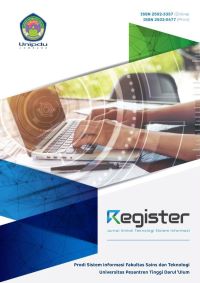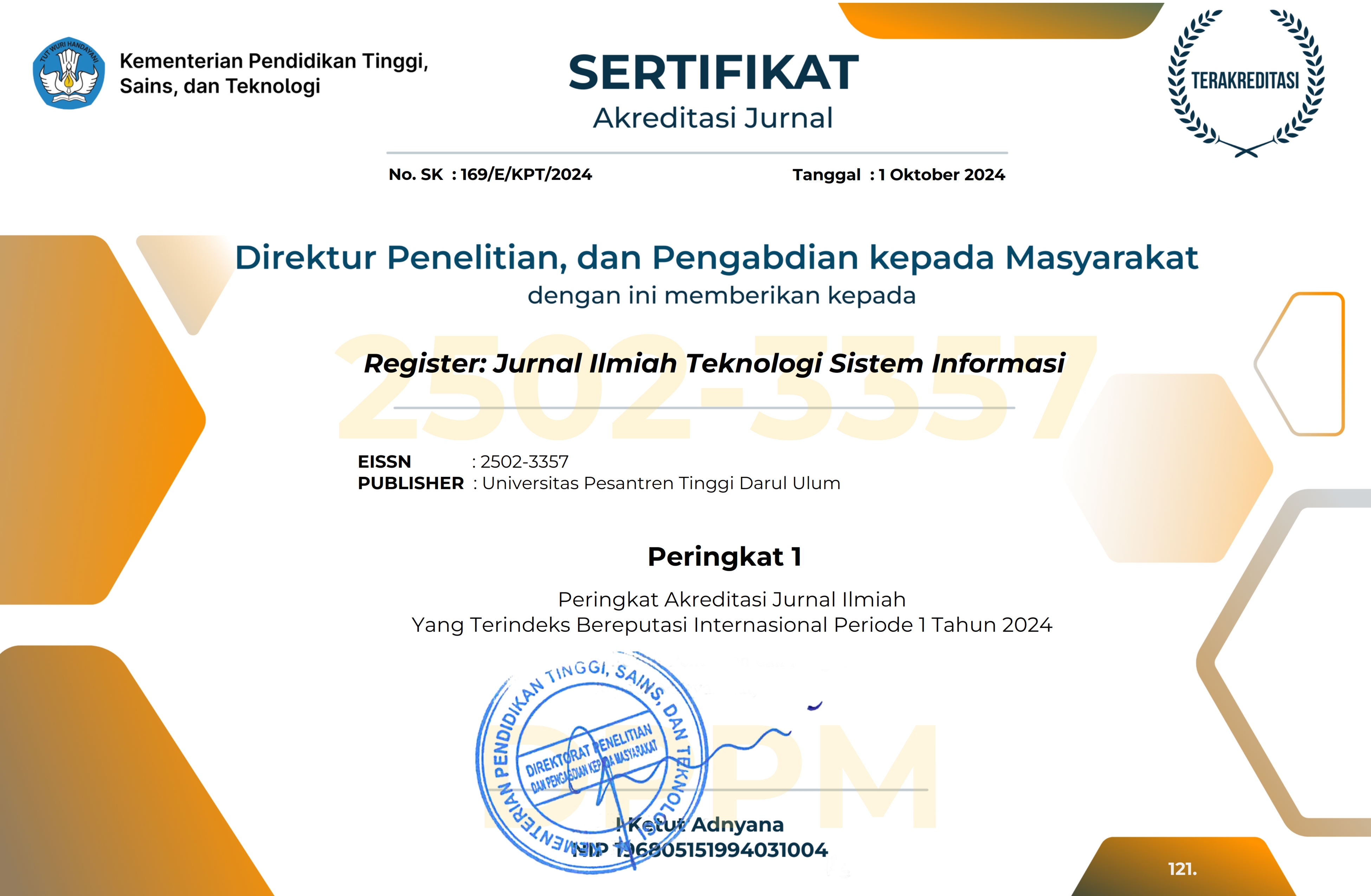Improving Urban Heat Island Predictions Using Support Vector Regression and Multi-Sensor Remote Sensing: A Case Study in Malang
https://doi.org/10.26594/register.v10i2.5022
Keywords:
urban heat island, Land Surface Temperature, Deep Learning, Prediction, Machine LearningAbstract
The Urban Heat Island (UHI) phenomenon is characterized by higher temperatures in urban areas compared to surrounding rural areas. This condition poses various environmental risks and adversely impacts public health, particularly in Malang, Indonesia. This study aims to predict land surface temperature (LST) in Malang to better understand and mitigate the effects of UHI's. Support Vector Regression (SVR) is employed using remote sensing data from Landsat-8, Sentinel-2, and SRTM. Normalized Difference Vegetation Index (NDVI), Normalized Difference Built-up Index (NDBI), Normalized Difference Water Index (NDWI), Normalized Difference Moisture Index (NDMI), elevation, and LST are calculated and normalized to ensure accurate data representation. Model testing results indicate that the Radial Basis Function (RBF) kernel performs best with hyperparameter settings of C = 10, Epsilon = 0.1, and gamma = 1. This model achieves an R² of 0.887, an MSE of 1.625, and a MAPE of 2.71%. These findings confirm that SVR with an appropriately tuned RBF kernel can improve prediction accuracy. Consequently, the study provides a robust foundation for developing more effective predictive models to address UHI management in urban areas.
Downloads
References
[1] A. Al Kafy et al., “The operational role of remote sensing in assessing and predicting land use/land cover and seasonal land surface temperature using machine learning algorithms in Rajshahi, Bangladesh,” Appl. Geomatics, vol. 13, no. 4, pp. 793–816, 2021, doi: 10.1007/s12518-021-00390-3.
[2] Z. Jandaghian and A. Colombo, “The Role of Water Bodies in Climate Regulation: Insights from Recent Studies on Urban Heat Island Mitigation,” Buildings, vol. 14, no. 9, 2024, doi: 10.3390/buildings14092945.
[3] M. Unal Cilek and A. Cilek, “Analyses of land surface temperature (LST) variability among local climate zones (LCZs) comparing Landsat-8 and ENVI-met model data,” Sustain. Cities Soc., vol. 69, no. 6, p. 102877, 2021, doi: 10.1016/j.scs.2021.102877.
[4] Y. Murayama and R. Wang, “Editorial: Special Issue on Geographical Analysis and Modeling of Urban Heat Island Formation,” Remote Sens., vol. 15, no. 18, pp. 1–5, 2023, doi: 10.3390/rs15184474.
[5] L. Gawuc, M. Jefimow, K. Szymankiewicz, M. Kuchcik, A. Sattari, and J. Struzewska, “Statistical Modeling of Urban Heat Island Intensity in Warsaw, Poland Using Simultaneous Air and Surface Temperature Observations,” IEEE J. Sel. Top. Appl. Earth Obs. Remote Sens., vol. 13, pp. 2716–2728, 2020, doi: 10.1109/JSTARS.2020.2989071.
[6] M. Dede, C. Asdak, and I. Setiawan, “Spatial dynamics model of land use and land cover changes: A comparison of CA, ANN, and ANN-CA,” Regist. J. Ilm. Teknol. Sist. Inf., vol. 8, no. 1, pp. 38–49, 2022, doi: 10.26594/register.v8i1.2339.
[7] T. Kusumadewi et al., “Urban Phytoarchitecture Design Options: Greenspace Orientation and Tree Species Intensification,” J. Adv. Res. Appl. Sci. Eng. Technol., vol. 31, no. 1, pp. 183–196, 2023, doi: 10.37934/araset.31.1.183196.
[8] Q. Xie and Q. Sun, “Monitoring thermal environment deterioration and its dynamic response to urban expansion in Wuhan, China,” Urban Clim., vol. 39, no. 8, p. 100932, 2021, doi: 10.1016/j.uclim.2021.100932.
[9] Z. A. Rahaman et al., “Assessing the impacts of vegetation cover loss on surface temperature, urban heat island and carbon emission in Penang city, Malaysia,” Build. Environ., vol. 222, 2022, doi: 10.1016/j.buildenv.2022.109335.
[10] P. Kumari, V. Garg, R. Kumar, and K. Kumar, “Impact of urban heat island formation on energy consumption in Delhi,” Urban Clim., vol. 36, no. 12, p. 100763, 2021, doi: 10.1016/j.uclim.2020.100763.
[11] E. A. Storey, K. R. Lee West, and D. A. Stow, “Utility and optimization of LANDSAT-derived burned area maps for southern California,” Int. J. Remote Sens., vol. 42, no. 2, pp. 486–505, 2021, doi: 10.1080/01431161.2020.1809741.
[12] A. Addas, “Machine Learning Techniques to Map the Impact of Urban Heat Island: Investigating the City of Jeddah,” Land, vol. 12, no. 6, 2023, doi: 10.3390/land12061159.
[13] M. Varentsov, M. Krinitskiy, and V. Stepanenko, “Machine Learning for Simulation of Urban Heat Island Dynamics Based on Large-Scale Meteorological Conditions,” Climate, vol. 11, no. 10, pp. 1–24, 2023, doi: 10.3390/cli11100200.
[14] A. K. Taloor, Drinder Singh Manhas, and G. Chandra Kothyari, “Retrieval of land surface temperature, normalized difference moisture index, normalized difference water index of the Ravi basin using Landsat data,” Appl. Comput. Geosci., vol. 9, no. August 2020, p. 100051, 2021, doi: 10.1016/j.acags.2020.100051.
[15] A. Kristianto, E. Sediyono, and K. D. Hartomo, “Implementation dbscan algorithm to clustering satellite surface temperature data in indonesia,” Regist. J. Ilm. Teknol. Sist. Inf., vol. 6, no. 2, pp. 109–118, 2020, doi: 10.26594/register.v6i2.1913.
[16] A. Mathew, S. Sreekumar, S. Khandelwal, and R. Kumar, “Prediction of land surface temperatures for surface urban heat island assessment over Chandigarh city using support vector regression model,” Sol. Energy, vol. 186, no. 6, pp. 404–415, 2019, doi: 10.1016/j.solener.2019.04.001.
[17] M. T. G. Furuya et al., “A machine learning approach for mapping surface urban heat island using environmental and socioeconomic variables: a case study in a medium-sized Brazilian city,” Environ. Earth Sci., vol. 82, no. 13, pp. 1–14, 2023, doi: 10.1007/s12665-023-11017-8.
[18] A. Previati and G. B. Crosta, “Characterization of the subsurface urban heat island and its sources in the Milan city area, Italy,” Hydrogeol. J., vol. 29, no. 7, pp. 2487–2500, 2021, doi: 10.1007/s10040-021-02387-z.
[19] S. Jain, S. Sannigrahi, S. Sen, and S. Bhatt, “Urban heat island intensity and its mitigation strategies in the fast- growing urban area,” J. Urban Manag., vol. 9, no. 1, pp. 54–66, 2020, doi: 10.1016/j.jum.2019.09.004.
[20] C. R. de Almeida, A. C. Teodoro, and A. Gonçalves, “Study of the urban heat island (Uhi) using remote sensing data/techniques: A systematic review,” Environments - MDPI, vol. 8, no. 10. 2021. doi: 10.3390/environments8100105.
[21] K. H. Suradiradja, I. S. Sitanggang, L. Abdullah, and I. Hermadi, “Estimation of biomass of forage sorghum (sorghum bicolor) Cv. Samurai-2 using support vector regression,” Indones. J. Electr. Eng. Comput. Sci., vol. 30, no. 3, pp. 1786–1794, 2023, doi: 10.11591/ijeecs.v30.i3.pp1786-1794.
[22] S. Liu and Q. Shi, “Local climate zone mapping as remote sensing scene classification using deep learning: A case study of metropolitan China,” ISPRS J. Photogramm. Remote Sens., vol. 164, pp. 229–242, 2020, doi: 10.1016/j.isprsjprs.2020.04.008.
[23] Q. Klopfenstein and S. Vaiter, “Linear support vector regression with linear constraints,” Mach. Learn., vol. 110, no. 7, pp. 1939–1974, 2021, doi: 10.1007/s10994-021-06018-2.
[24] D. Parbat and M. Chakraborty, “A python based support vector regression model for prediction of COVID19 cases in India,” Chaos, Solitons and Fractals, vol. 138, p. 109942, 2020, doi: 10.1016/j.chaos.2020.109942.
[25] I. Izonin, R. Tkachenko, N. Horbal, M. Greguš, V. Verhun, and Y. Tolstyak, “An Approach Toward Numerical Data Augmentation and Regression Modeling Using Polynomial-Kernel-Based SVR,” in Lecture Notes in Networks and Systems, M. Saraswat, S. Roy, C. Chowdhury, and A. H. Gandomi, Eds., Singapore: Springer Singapore, 2022, pp. 771–781. doi: 10.1007/978-981-16-5120-5_58.
[26] K. Tscharke, S. Issel, and P. Debus, “Semisupervised Anomaly Detection using Support Vector Regression with Quantum Kernel,” Proc. - 2023 IEEE Int. Conf. Quantum Comput. Eng. QCE 2023, pp. 611–620, 2023, doi: 10.1109/QCE57702.2023.00075.
[27] A. A. Ajhari, “The Comparison of Sentiment Analysis of Moon Knight Movie Reviews between Multinomial Naive Bayes and Support Vector Machine,” Appl. Inf. Syst. Manag., vol. 6, no. 1, pp. 13–20, 2023, doi: 10.15408/aism.v6i1.26045.
[28] Y. Zheng, W. Li, C. Fang, B. Feng, Q. Zhong, and D. Zhang, “Investigating the Impact of Weather Conditions on Urban Heat Island Development in the Subtropical City of Hong Kong,” Atmosphere (Basel)., vol. 14, no. 2, 2023, doi: 10.3390/atmos14020257.
Downloads
Published
How to Cite
Issue
Section
License
Copyright (c) 2024 Yunifa Miftachul Arif, Salma Ainur Rohma, Hani Nurhayati, Taranita Kusumadewi, Fresy Nugroho, Ahmad Fahmi Karami

This work is licensed under a Creative Commons Attribution-NonCommercial-ShareAlike 4.0 International License.
Please find the rights and licenses in Register: Jurnal Ilmiah Teknologi Sistem Informasi. By submitting the article/manuscript of the article, the author(s) agree with this policy. No specific document sign-off is required.
1. License
The non-commercial use of the article will be governed by the Creative Commons Attribution license as currently displayed on Creative Commons Attribution-NonCommercial-ShareAlike 4.0 International License.
2. Author(s)' Warranties
The author warrants that the article is original, written by stated author(s), has not been published before, contains no unlawful statements, does not infringe the rights of others, is subject to copyright that is vested exclusively in the author and free of any third party rights, and that any necessary written permissions to quote from other sources have been obtained by the author(s).
3. User/Public Rights
Register's spirit is to disseminate articles published are as free as possible. Under the Creative Commons license, Register permits users to copy, distribute, display, and perform the work for non-commercial purposes only. Users will also need to attribute authors and Register on distributing works in the journal and other media of publications. Unless otherwise stated, the authors are public entities as soon as their articles got published.
4. Rights of Authors
Authors retain all their rights to the published works, such as (but not limited to) the following rights;
Copyright and other proprietary rights relating to the article, such as patent rights,
The right to use the substance of the article in own future works, including lectures and books,
The right to reproduce the article for own purposes,
The right to self-archive the article (please read out deposit policy),
The right to enter into separate, additional contractual arrangements for the non-exclusive distribution of the article's published version (e.g., post it to an institutional repository or publish it in a book), with an acknowledgment of its initial publication in this journal (Register: Jurnal Ilmiah Teknologi Sistem Informasi).
5. Co-Authorship
If the article was jointly prepared by more than one author, any authors submitting the manuscript warrants that he/she has been authorized by all co-authors to be agreed on this copyright and license notice (agreement) on their behalf, and agrees to inform his/her co-authors of the terms of this policy. Register will not be held liable for anything that may arise due to the author(s) internal dispute. Register will only communicate with the corresponding author.
6. Royalties
Being an open accessed journal and disseminating articles for free under the Creative Commons license term mentioned, author(s) aware that Register entitles the author(s) to no royalties or other fees.
7. Miscellaneous
Register will publish the article (or have it published) in the journal if the article’s editorial process is successfully completed. Register's editors may modify the article to a style of punctuation, spelling, capitalization, referencing and usage that deems appropriate. The author acknowledges that the article may be published so that it will be publicly accessible and such access will be free of charge for the readers as mentioned in point 3.




















